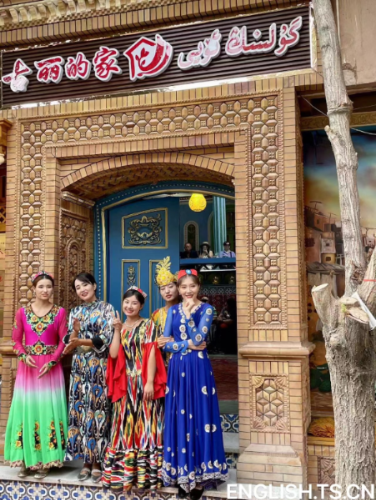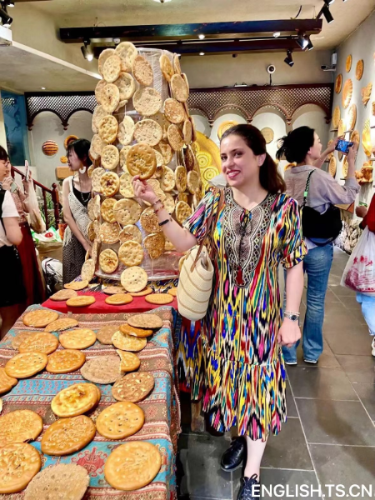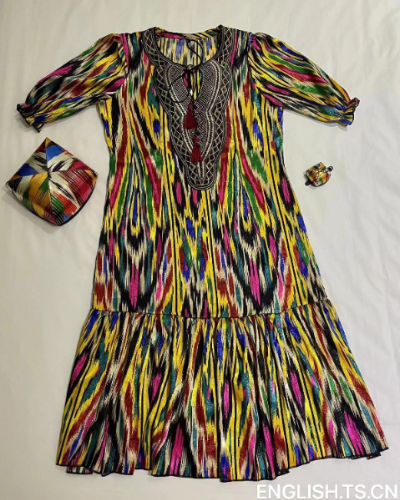I am an Iranian journalist and tourist who has visited many places around the world.
My first visit to China was in 2014, during which I traveled through this country as a tourist. This year I returned to China for the second time, but this time as a journalist.
At the end of February, I was invited by the Chinese Embassy in my country to participate in a four-month program organized by the Chinese Ministry of Foreign Affairs for journalists from more than 90 countries. I participated in this interesting and informative program that lasted more than four months, and according to the plan that was made for us, we visited several provinces in China during our stay. The last visited province was Xinjiang in northwest China.
Although all the regions I visited during my stay in China were special and spectacular in their own way, visiting Xinjiang Uygur Autonomous Region was the biggest surprise of that trip for me. Xinjiang was a place that impressed and fascinated me more and more every moment.
Here, I intend to share a part of my observations in this wonderful province in a series of articles, and this article is the first part of this series.
Our trip to Xinjiang started from the city of Kashi in southwestern Xinjiang. It is one of the westernmost cities of China, located near the country's border.For over 2,000 years, Kashi was a strategically important oasis on the Silk Road between China, the Middle East, and Europe. It is one of the oldest continuously inhabited cities in the world.

A photo of local people in ethnic costumes taken by Mahnaz Abdi in the ancient city of Kashi, Kashi Prefecture, northwest China’s Xinjiang Uygur Autonomous Region.
The first thing that attracted my attention when I entered Xinjiang was the Uygur handwriting that was very similar to my handwriting. I saw this handwriting first in the airport of Kashi, and I was so excited, as I could read some of the words.
We arrived at the hotel in the evening and went directly to the dining hall for dinner. The salon was decorated with Uygur characteristics fabrics that featured a beautiful pattern.
In fact, traditional Uygur clothing, especially for females, is very colorful, and reflects the rich history and culture of the Uygurs.
The buffet tables were also decorated with naan (a kind of Uygur traditional bread, we also call bread “Nan” in our language Persian) and Chinese dates.

Mahnaz Abdi in a naan display shop in northwest China’s Xinjiang Uygur Autonomous Region.
Then we sat around the round table for dinner. Every dish was so delicious, but the Kabab (barbequed lamb) with naan was exceptionally tasty that I can never forget its flavor.
Also, an excellent and unique type of tea was served with dinner, which I really enjoyed drinking and found it relieved my tiredness. I learned in the following days that tea holds a special place in Xinjiang culture and that there is a wide variety of teas available in this province.
During our three-day stay in Kashi, we visited many places. Among them, the ancient city of Kashi, located in the center of Kashi, was the most interesting one.
Covering an area of 4.25 square kilometers, the ancient city presents a vivid picture of Xinjiang Uygur folk customs.
It is said that the soul of Kashi lies in the ancient city of Kashi, which represents both its ancient past and peaceful present.
Most of the buildings in the ancient city have been renovated while retaining their local features. The colorful walls, round arches, beautifully designed doors and windows provide a perfect backdrop for your pictures.
In addition to the architecture, many characteristic shops on the streets are also worth visiting.
In the Bazaar (market in Uygur language), there were so many attractive shops selling traditional clothes and handicrafts, that it was hard to resist the temptation to shop. So, like other members of our group, I bought some specific items for myself and also some souvenirs for my family and friends.

A photo of an ethnic Uygur Atlas dress and doppa for female taken by Mahnaz Abdi.
Actually, on the first day of our stay in Kashi, I purchased a set of Uygur dress and doppa (a square or round skullcap originating in Central Asia), and throughout my entire stay in Xinjiang, I wore them and took many beautiful and memorable photos in the nice unique clothes.
In the ancient city of Kashi, there are also some residences available for visiting, where you can experience the typical local house.
We visited one of the houses that were open for tourists and enjoyed eating delicious fresh local fruits and nuts, as well as watching local dances in that place.
We visited the ancient city twice, once during the day time, and once at night. I also recommend you to visit this wonderful place both during the day and at night.
My three-day stay in Kashi, which is called the Jewel, the Gem, and the Heart of the Silk Road, was one of my most special and unique experiences in a city. From the natural beauty of the city to its ancient charm,from its kind and friendly people to its fresh and delicious food- these are all characteristics that make visiting this city an unforgettable memory for every visitor.
From the natural beauty of the city to its ancient charm, from its kind and friendly people to its fresh and delicious food - these are all characteristics that make visiting this city an unforgettable memory for every visitor.
Mahnaz Abdi is an editor at Tehran Times, a leading Iranian newspaper.
Producer: Xiao Chunfei
Supervisors: Ding Tao and Jie Wenjin
Planners: Jie Wenjin and Cheng Li
Reviewers: Wang Xiabing and Hou Weili
Editor: Gvlzar Mijit









